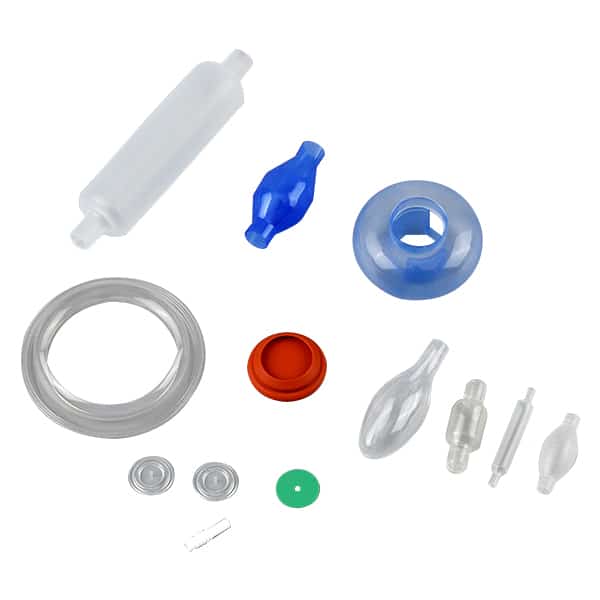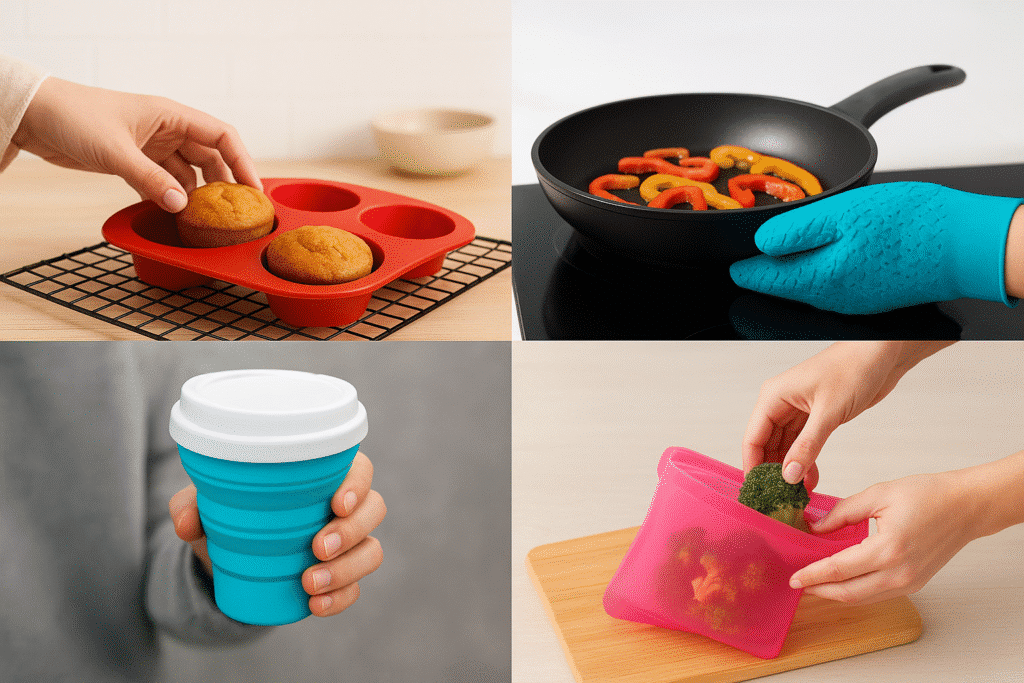Rubber melting point and thermal degradation temperature
In the field of rubber and silicone elastic materials, the concept of “melting point” is often misused, because both are thermosetting or thermoplastic materials, their thermal properties are very different. This article starts with the issue of “rubber melting point” and helps engineers, buyers and brands to scientifically understand thermal properties and make material selection decisions through actual measurement feedback and standard analysis.
What is Rubber?
Rubber refers to a highly elastic polymer material with reversible deformation. It is elastic at room temperature and can produce large deformation under very small external force. It can return to its original shape after the external force is removed. Rubber is a completely amorphous polymer with a low glass transition temperature (Tg) and a large molecular weight, greater than hundreds of thousands.
Rubber is divided into two types: natural rubber and synthetic rubber. Natural rubber is processed from gum extracted from plants such as rubber trees and rubber grass; synthetic rubber is obtained by polymerization of various monomers. Rubber products are widely used in industry or various aspects of life.

What is Rubber Melting Point?
As a polymer material, rubber does not have a fixed melting point. Its physical properties are that it gradually softens when the temperature rises, and it will crack (carbonize) instead of melt when it exceeds a certain temperature.
Softening and cracking: Rubber first softens at high temperatures (such as natural rubber starts to soften at 130-140℃), and then gradually cracks, producing gas and may burn.
Carbonization temperature: The carbonization temperature of natural rubber is about 300℃, and it completely decomposes when it exceeds 400℃.
Practical application: Rubber products such as tires may cause the risk of blowout due to increased tire pressure at high temperatures (such as 70℃ on summer roads), but the rubber itself will not melt due to high temperatures.
- Natural rubber: softening starts at about 60–70°C, and complete chemical decomposition occurs at 200–250°C.
- Synthetic rubber (such as SBR, NBR, EPDM): thermal degradation temperature is 180–250°C.
- Silicone rubber: stable structure, higher thermal decomposition range, usually 250–300°C, short-term up to 320°C+.
Why should we pay attention to the melting point of rubber?
When we are making products or projects, choosing the right materials helps to ensure the stability and safety of the products in high temperature environments; if the selected materials do not meet the expected heat resistance, they are prone to softening, brittle cracking, release of harmful substances or deformation. Therefore, it is so important to know the melting points of different types of rubber.
Who concerned the rubber melting point?
Manufacturers’ engineers and product designers, when this product is used in high-temperature environments such as seals, kitchen tools, and electrical components, these professionals need to understand the melting point or heat resistance of this accessory in order to ensure the reliability and stability of the entire product when designing or using these products as accessories.
Purchasers or brand owners of this product need to pay attention to product reliability, cost, and compliance. In order to make this brand’s products reliable and stable in the market.
As end consumers, if they use rubber kitchen utensils and pot mats that are easily exposed to high temperatures, they will also be concerned about this issue.
When should we pay attention to the melting point and heat resistance of rubber?
Determine heat-resistant specifications during the product design phase; designers need to select high-temperature resistant materials based on melting point data and heat-resistant specifications, and optimize heat dissipation design to extend the service life of rubber parts
During rubber processing, the thermal stability of the material needs to be evaluated through melting point determination to ensure that the processing temperature does not exceed the material’s tolerance limit to avoid carbonization or performance degradation
Long-term high-temperature environments, daily baking, steam sterilization, and other high-temperature applications may cause rubber carbonization or deformation. It is necessary to regularly check the aging of components such as tires and seals and replace them in time;
In addition, an oxidation/aging test phase is required before rubber products are put on the market in batches.
Where you need use the heat resistance rubber?
How to determine the melting point and heat resistance of rubber?
Differential Scanning Calorimetry (DSC)
By measuring the heat flow change of the sample during heating, determine the temperature corresponding to the melting endothermic peak. The softening point of natural rubber is about 120-140℃, nitrile rubber begins to soften at 150-200℃, and fluororubber can reach above 200℃.
Thermomechanical Analysis (TMA)
Judgment of softening point by monitoring deformation, suitable for cross-linked or filled rubber.
Natural softening temperature, chemical degradation temperature and physical properties match;
Traditional methods
Such as capillary method to observe flow temperature (accuracy of about ±5℃), suitable for rapid detection of unvulcanized rubber.
Heat resistance evaluation Decomposition temperature : nitrile rubber is about 250-300℃, chloroprene rubber is about 130℃ (but in actual use, heat resistance is affected by the formula).
Long-term use temperature: Ordinary rubber such as nitrile rubber can withstand 150-200℃ in the short term, but it is easy to decompose in long-term high temperature; fluororubber has the best heat resistance and can be used for a long time above 200℃
Based on the product parameter report provided by the supplier, the material adaptation is evaluated in combination with the actual use environment and duration.
How to produce the rubber?
Natural rubber mainly comes from Hevea brasiliensis. When the skin of this rubber tree is cut, milky white juice will flow out, which is called latex. The latex is condensed, washed, molded and dried to obtain natural rubber. Synthetic rubber is made by artificial synthesis. Different types of rubber can be synthesized using different raw materials (monomers).

From 1900 to 1910, chemist C.D. Harris determined that the structure of natural rubber is a polymer of isoprene, which opened up a way for artificial synthetic rubber.
In 1910, Russian chemist SV Lebedev (1874-1934) used metallic sodium as an initiator to polymerize 1,3-butadiene into sodium butadiene rubber. Later, many new synthetic rubber varieties appeared one after another, such as butadiene rubber, chloroprene rubber, styrene butadiene rubber, etc. The output of synthetic rubber has greatly exceeded that of natural rubber, among which styrene butadiene rubber has the largest output.

How much temperature can rubber withstand?
- Softening starting temperature: natural rubber 60°C, synthetic rubber 80°C, silicone -60~.
- Stable temperature range: natural/synthetic rubber 100~150°C (some can reach 200°C).
- Decomposition temperature: natural rubber 200~250°C, high temperature resistant rubber 370~400°C; silicone decomposition zone 250~320°C.
How to choose the correct rubber?
The temperature resistance of the material is selected based on the product use temperature as the primary reference value.
If the design temperature is >200°C, it is recommended to use silicone or high-temperature synthetic rubber.
Synthetic rubber is more cost-effective at low temperatures <80°C.
How to control the properties of rubber?
The melting point and heat resistance of rubber are mainly achieved through molecular structure adjustment and processing technology control:
Molecular structure optimization
Blending modification: Improve the overall heat resistance by adding synthetic rubber (such as nitrile rubber, fluororubber) or recycled rubber (such as butyl recycled rubber) with good heat resistance.
Crosslinking bond optimization: The use of peroxide crosslinking system (such as RT88) can improve heat resistance, and its crosslinking bond stability is better than the traditional sulfur vulcanization system.
Adjustment of acrylonitrile content: The higher the acrylonitrile content in nitrile rubber, the better the heat resistance, but the processing performance needs to be balanced.
Processing technology control
Vulcanization system adjustment: Use a low-sulfur high-promoting vulcanization system or a balanced vulcanization system to reduce the formation of polysulfide bonds and improve the stability of crosslinking bonds.
Peroxide vulcanization (such as RT88) can form carbon-carbon bonds, and the heat resistance is better than the traditional sulfur vulcanization system.
Vulcanization parameter optimization: Strictly control the temperature and time to avoid reversion due to excessive vulcanization (especially for natural rubber).
Use segmented vulcanization process to improve vulcanization uniformity.
Material selection and protection Filling system: Add high temperature resistant inorganic fillers (such as graphite, silica) to reduce heat conduction.
Protective agent: Use antioxidants, anti-ultraviolet agents, etc. to extend service life.
How to clean and maintain rubber products?
Cleaning and maintaining rubber products require choosing the appropriate method according to the material and usage scenario. The following are specific suggestions:
Daily cleaning
Dust treatment: Use a vacuum cleaner or a soft brush to gently sweep the surface to remove dust and impurities.
Mild detergent: Dilute a neutral detergent (such as detergent, laundry detergent) in warm water, wipe with a soft cloth, and avoid strong acid and alkali detergents.
Gap cleaning: Use a cotton swab or a soft toothbrush to dip the cleaning solution into the gap and wipe it deeply. Clean it at least once a week.
Deep cleaning
Immersion cleaning: Soak the rubber product in water containing detergent, scrub it carefully with a soft brush, rinse it with clean water and dry it.
Special stains: Aged sticky: Wipe with alcohol, baking soda or nail polish remover to remove aged gum.
Mold stains and odors: Mix vinegar and hot water in a 1:1 ratio and wipe it. Avoid using bleach.
Maintenance and Care
Avoid exposure to sunlight: Store in a cool and dry place, away from direct sunlight and high temperature.
Lubricated parts: Regularly use special rubber lubricants or silicone-based lubricating pastes to maintain moving parts (such as seals) to prevent dry wear.
Check for damage: Observe for cracks, tears or holes during cleaning, and replace damaged parts in time.
More FAQs
Summary
Rubber has no real melting point, and its “melting” is softening and gradual decomposition; the softening temperature of natural rubber is about 60-70°C, and the degradation temperature is 200-250°C; most synthetic rubbers have thermal stability of up to 180-250°C, and special rubbers are even higher; silicone has better thermal performance, with a decomposition temperature of 250-320°C, suitable for high-temperature applications.
Material selection is recommended based on temperature resistance requirements, usage scenarios and cost-effectiveness, and technical support and test reports are provided to select matching materials. If you need to match materials according to your product requirements, our expert team can provide one-stop support to help you accurately select materials and quickly increase production.
Further Reading
Technical Related
About Author: Z.S.R International Group
Z.S.R International Group(Hong Kong) co., Limited, is a one-stop supplier for molded silicone products and silicone products molding solution provider in the consumer products field. We offer OEM services from silicone product design to Silicone products contract manufacturing. We have the capability for custom silicone tooling, LSR(Liquid silicone Rubber) molded silicone products, solid silicone molded products, molded silicone multi-colored products. We also can custom molded silicone, custom molded LSR, custom molded dripping injection dispensing(co-injection) silicone multi-colored products.








